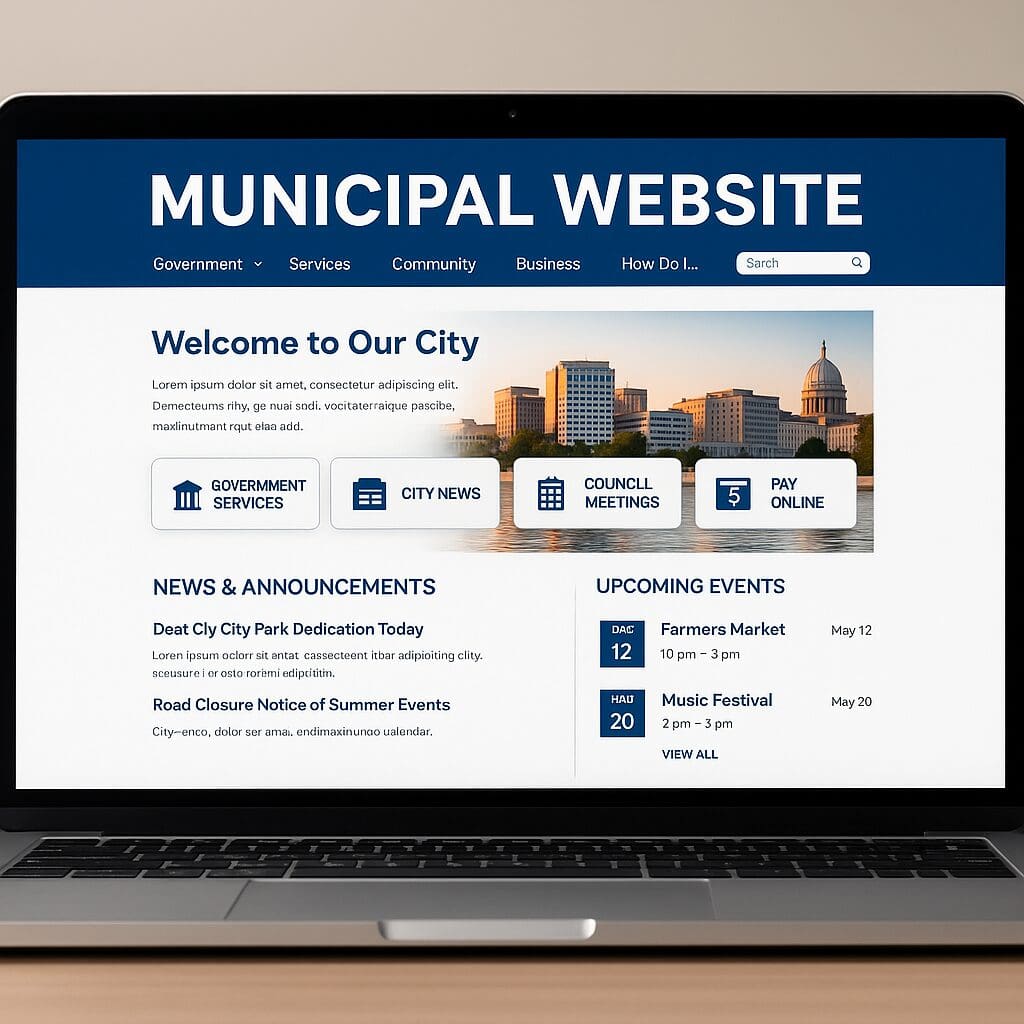A municipal website goes far beyond being merely a digital bulletin board. It serves as the central hub for communication within a contemporary city or town, linking government officials, citizens, businesses, and visitors around the clock. This platform embodies transparency, trust, and effective service delivery—all in one convenient online location.
Curious about what makes a municipal website truly effective? You’re in the right place to discover why it’s essential and which features distinguish the remarkable from the mediocre.
Municipal Website: A Clear Definition
At its essence, a municipal website serves as the official portal for a city, town, or local governmental body. Managed by local authorities, it acts as a public gateway to everything from city council updates to the ability to pay water bills.
However, an exemplary municipal website is not just a collection of phone numbers. It serves as an interactive platform that enables public access to records, allows citizens to submit service requests, provides real-time updates, and fosters community engagement. As we approach 2025, if your town’s website lacks these functionalities, it’s falling behind the curve.
For an inspiring look at what modern municipal websites can accomplish, check out SnapSite’s municipal website design, tailored specifically for the needs of cities and counties.
The Importance of a High-Quality Municipal Website
So, why should cities invest in enhancing their websites? Here are several compelling reasons:
- Always Accessible Services. Residents expect to be able to pay bills, report issues, or find information even after standard office hours. A municipal website operates 24/7.
- Efficiency in Time and Cost. Instead of needing to make calls or visit city hall, residents can manage tasks online. This reduces the demand on staff, minimizes lines at government offices, and cuts down on paper usage.
- Fosters Trust and Transparency. By publishing meeting agendas, budgets, and official ordinances online, municipalities demonstrate their commitment to openness, an essential aspect of local democracy.
- Streamlines Information Flow. Instead of scattered information across social media platforms or outdated newsletters, the website functions as a singular source of accurate information.
These aren’t mere hypotheses. Cities utilizing platforms like SnapSite.us report reduced administrative workloads, heightened citizen engagement, and quicker service request responses.
Essential Features for a User-Friendly Experience
Say goodbye to mundane websites that feel trapped in the early 2000s. Here’s what a robust municipal website should offer, broken down by practical use:
1. Seamless Online Payments and Transactions
Paying your water bill or renewing a business license shouldn’t necessitate a trip to city hall. A well-designed municipal website facilitates secure online payments in just a few clicks, making it not just convenient but an expected feature.
2. Easy Access to Public Records and Agendas
City council minutes and publicly mandated records should never be hard to find. On a modern municipal website, these documents shouldn’t be hidden in complicated directories. SnapSite’s digital document solutions assist cities in organizing and publishing all agendas and documents for straightforward access and download. This is the backbone of open government.
3. Timely News and Emergency Alerts
In the event of emergencies like water main breaks or severe weather, the city’s website is often the first place residents check. Exceptional municipal websites provide emergency banners, pop-up alerts, and timely news updates—connecting with citizens where they already seek information.
4. Service Requests and 311 Reporting
Fed up with potholes or malfunctioning streetlights? A municipal website should offer 311-style online reporting, allowing residents to report issues, upload photos, and receive updates on progress. This approach reduces unnecessary phone calls and promotes accountability.
SnapSite’s 311 features streamline this process, making it easy to launch and manage even for smaller communities.
5. Community Events, Calendars, and Resources
Information on local events, council meetings, and recreational programs shouldn’t be difficult to locate. An organized and integrated calendar can boost overall community engagement by making this information easily accessible.
6. Comprehensive Directories and Contact Information
If you’re searching for the parks department or your local council representative, a clear and user-friendly staff directory with accessible contact forms can save valuable time and alleviate frustration. Quality municipal websites utilize mobile-friendly, searchable layouts.
7. Streamlined Forms and Applications
Whether for a building permit, dog license, or volunteer signup, transitioning from paper forms to online submissions leads to speedier processing and direct routing to staff, alongside digital confirmations for residents. This upgrade benefits everyone involved.
Who are the Users of Municipal Websites?
- Local Residents: Primarily a source for bill payments, information on garbage collection, council news, and submitting service requests.
- Business Owners: Frequently utilize city websites for permits, fee payments, zoning checks, and reviewing regulations.
- Visitors and Tourists: Well-structured sites spotlight local attractions, parks, festivals, and visitor services.
- City Officials and Staff: Access the backend to manage content, track service requests, and enhance internal operations.
- Community Organizations and Media: Depend on the site for the latest announcements, agendas, and press releases.
In a nutshell: A complicated municipal website frustrates all of these user groups swiftly.
The Significance of Transparency, Communication, and Engagement
Transparency is not just a trendy phrase; it’s a legal and ethical obligation. The best municipal websites:
- Publish meeting notices and agendas prior to council meetings (as required by open meetings laws).
- Share annual budgets, audits, and strategic development plans.
- Maintain a historical archive of ordinances and resolutions.
- Provide clear methods for residents to get in touch with staff, submit inquiries, or provide public comments.
This degree of openness results in enhanced community trust and a more informed, engaged public. A prime example of this proactive approach can be found at MyCityGov.com, illustrating how cities can effectively manage digital engagement.
Emerging Trends in Municipal Website Design
The design of municipal websites is evolving rapidly. Here are some key trends that are becoming the norm:
Accessibility (ADA & WCAG Compliance)
It’s essential that everybody can navigate your site effectively. This entails implementing screen reader support, keyboard navigation, high-contrast themes, and including alt text for images.
SnapSite incorporates accessibility into every project, simplifying compliance.
Mobile-First and Responsive Design
Since a majority of visitors access city sites through their smartphones, having a mobile-friendly design is crucial. Responsive layouts are essential for both search engine rankings and overall user satisfaction.
Secure Online Services
As online transactions increase, so does the necessity for security. SSL encryption, data privacy measures, and routine security updates are foundational for reliable websites. SnapSite’s security-centric strategy ensures data remains safeguarded.
Integrated Digital Services
Consolidated access to online forms, payment systems, document archives, and interactive maps creates a seamless user experience—eliminating the need for fragmented systems or third-party services.
AI and Chatbots
Many larger municipalities are beginning to utilize chatbots to address common inquiries, providing service 24/7. This will likely become a standard expectation in the coming years.
Key Elements of an Outstanding Municipal Website (Best Practices)
- Intuitive Navigation: Users should be able to find what they need in two clicks.
- Swift Load Times: Slow websites deter visitors.
- Consistent Branding: Reinforces trust and professionalism.
- Regular Updates: Information should reflect current realities; your website should evolve accordingly.
- Data Analytics and Feedback: Utilizing analytics helps improve both website content and structure.
For a practical illustration, explore SnapSite’s municipal website design gallery, or examine live municipal sites crafted for enhanced usability and high engagement.
Experience the Example: MyCityGov.com
A shining example of effective implementation is MyCityGov.com. Its homepage presents clear and welcoming information, is optimized for mobile devices, and offers a wealth of digital services. Residents can conveniently pay bills, submit requests, and access city council updates without sifting through outdated pages. This sets a new standard for municipal websites.
Conclusion and Next Steps
A municipal website is far more than a mere online announcement board; it’s the crucial backbone of modern local governance. When constructed appropriately, it reduces operational costs, enhances transparency, and fosters civic trust. It simplifies life for residents, businesses, and officials alike.
If your city or town is prepared for a significant digital upgrade, don’t settle for cookie-cutter templates. Collaborate with a specialized provider.
Discover the possibilities at SnapSite’s municipal website design page, or witness an exemplary case at MyCityGov.com.
It’s time to create a website that your community deserves—streamlined, modern, and accessible to all.





